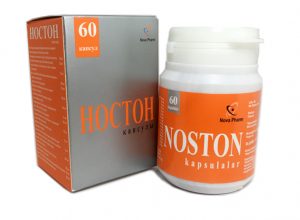
Product name: Noston
Active substance: Tribulus terrestris fruits (Tribulus terrestris), Kratevy bark (Сratevia nurvala), Potassium carbonate obtained from barley ash (Yavaksshar), Butii seeded colors (Butea monosperma), Potassium nitrate (Suryakshar), Barberry neural roots (Berberis aristata), Commiphora Mukul (Commiphora mukul), Achyranthes (Achyranthea aspera), Parpati (Swet parpati), Mimosa pudica seeds (Mimosa pudica), Radish ash (Raphanus sativus), Sodium chloride is treated in coconut shell (Cocus nucifera), Faba bean seeds (Dolichos biflorus), Mimosa Ash (Dichrostychus cinerea), Ervy woolly roots (Aervalanata), Coleus(Coleus ambonicus)
Dosage form: Сapsules
Composition:
One capsule contains:
Active substance:
Tribulus terrestris fruits (Tribulus terrestris) 250.0
Kratevy bark (Сratevia nurvala) 300.0
Potassium carbonate obtained from barley ash (Yavaksshar) 100,0
Butii seeded colors (Butea monosperma) 100,0
Potassium nitrate (Suryakshar) 100,0
Barberry neural roots (Berberis aristata) 300,0
Commiphora Mukul (Commiphora mukul) 150,0
Achyranthes (Achyranthea aspera) 150,0
Parpati (Swet parpati) 200,0
Mimosa pudica seeds (Mimosa pudica) 200,0
Radish ash (Raphanus sativus) 125,0
Sodium chloride is treated in coconut shell (Cocus nucifera) 100,0
Faba bean seeds (Dolichos biflorus) 300,0
Mimosa Ash (Dichrostychus cinerea), 30,0
Ervy woolly roots (Aerva lanata) 30,0
Coleus(Coleus ambonicus) 30,0
Excipient: colloidal silicon dioxide, talc purified.
Description: Hard gelatin capsules of size “0” dark red powder comprising friable brownish-green color with small elements of medicinal plants with a characteristic odor.
Pharmacotherapeutic group: Drugs used in nephrology and urology
Presentation: Syrup 200 ml plastic bottle, each bottle, together with instructions for use in a carton box.
Storage conditions: In a dry, dark place at a temperature no higher than 30 ° C
Shelf life: 3 years.
Conditions of supply of pharmacies: With recipe.
Рharmacolgical properties
Noston-combination herbal preparation.
Tribulus terrestris fruits (Tribulus terrestris)-It contains steroidal saponins (diosgenin, trillin, dioscin, diosponin, gracillins, protodioscin, kikubasaponin) sapogenins, flavonoids, alkaloids, vitamin C, fatty acids (linolenic, oleic, palmitic, stearic), resinous, dyes and tannins, macronutrients (K Ca, Mg, Fe) and trace elements (Mn, Cu, Zn). Liquid extract of Tribulus Terrestris increases bile secretion, stimulate the secretion of gastric juices, increases peristalsis.
Kratevy bark (Сratevia nurvala)- It contains flavonoids, glucosinolates, plant sterols, saponins, tannins. Antioxidant. It has litotripichnym and tonic properties. Bark Kratevy used in folk medicine as an anti-inflammatory, antipyretic, laxative, diuretic and anthelmintic.
Butii seeded colors (Butea monosperma)-has a beneficial effect on the digestive and circulatory system is an effective astringent, stimulant and styptic.
Barberry neural roots (Berberis aristata)- has choleretic, anti-inflammatory, antibacterial, analgesic, hemostatic, antispasmodic, antipyretic, anti-tumor properties. The roots are used as a diuretic in diseases of the kidneys, bladder, dropsy, kidney stones.
Commiphora Mukul (Commiphora mukul) – a small flowering shrub. It has a rejuvenating, stimulating, improves metabolism, strengthens the nerves, antispasmodic, analgesic, expectorant, astringent, antiseptic effect.
Achyranthes (Achyranthea aspera) – A perennial herb. Apply with insomnia, intestinal disorders, hydrophobia (rabies), for removal of the spleen, as in dropsy, rheumatism, diseases of cholera, stomach and skin. In the treatment of diarrhea and dysentery uses a decoction of the leaves. The juice of the plant is used to treat boils, hemorrhoids, dysentery, rheumatic pain, itching and skin rashes.
Mimosa pudica seeds (Mimosa pudica) – It contains tannin, alkaloid mimozin, calcium oxalate. It has antiseptic, anti-inflammatory, healing, astringent, hemostatic properties.
Radish ash (Raphanus sativus) – An annual or biennial plant of the genus radish, cabbage family. Early vegetable, restores the immune system after a long winter.
It contains ascorbic acid and folic acid, potassium, vitamin B6, riboflavin, magnesium, copper and calcium. Is used to treat a number of diseases – whooping cough, cancer, coughs, gastritis, liver disease and gall bladder, constipation, indigestion, arthritis, kidney stones and gallstone
Ervy woolly roots (Aervalanata) – Amaranth herb of the family, genus Ervy.
It has a pronounced diuretic effect, spasmolytic action and smooth muscle in the bile duct, ureter, and gastrointestinal tract.
When pyelonephritis and urolithiasis disease reduces swelling of the face and legs, signs of inflammation, promotes discharge of stones.
With stagnation in the gallbladder promotes discharge of bile and reduce the symptoms of inflammation.
Weakens a painful spasm of the muscles of the stomach during exacerbation of chronic gastritis.
The drug generally has a diuretic, antispasmodic, litholytic, antimicrobial and anti-inflammatory effect. The drug controls the crystal-colloid balance in dismetabolic nephropathy, reduces the concentration of elements in urine, contributing to the formation of stones (oxalic acid, calcium, hydroxyproline) increases the level of the elements that inhibit stone formation process leads to demineralization.
It prevents the accumulation of particles around the stone core, which prevents its further growth. Stimulates diuresis and relaxing the smooth muscles of the urinary tract, Noston promotes the excretion of oxalate and phosphate salts, uric acid and small stones from the urinary tract. Litholytic effect of the drug independent of the pH of urine.
Noston bacteriostatic and bactericidal action especially against Klebsiella spp., Pseudomonas aeruginosa, Escherichia coli and other gram-negative bacteria.
Indications
In the combined therapy:
– Urolithiasis and crystalluria (urate, oxalate, phosphate, korbonaty);
– Non-specific urinary tract infections (urethritis, cystitis, pyelonephritis);
– Dizuricheskih phenomena;
– Gout.
Relief of urinary tract spasms and colic.
Prevention of urolithiasis, including after removal or self discharge of stones.
Side effects
Allergic reactions.
Drug interactions
Not described.
Special instructions
Since the therapeutic effect Noston develops gradually, it is not recommended to stop taking the drug and should stop taking it only in case of acute pain in the urinary tract area.
Keep out of the reach of children, and it should not be used after the expiration date.
Overdose
In the event of an overdose of the drug can enhance the symptoms of side effects.
At the same time carrying out symptomatic treatment is necessary.
Contraindications
Hypersensitivity to the drug
 English
English Русский
Русский Uzbek
Uzbek